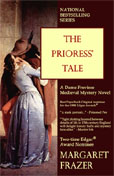The day had moved into the drowsy warmth of afternoon when Frevisse went out to the guest halls again, to see how things went and if all was well in hand for supper. As she crossed the yard she had the regretful thought that it was a pity these bright, dry days had waited for October instead of blessing them at harvest. They would have made a difference then. Now they were hardly better than illusion, their brief warmth gone as soon as the day began to fade, the cold returning with the sunset shadows that in these shortening days came ever earlier…
Whenever possible, the weather described in my stories is accurate to the time the stories are set. Unfortunately, the 1400s lacked such fulsome reporting as the Weather Channel and local news stations give us today, but careful searching of contemporary chronicles and documents and other sources provides far more detail than might be expected. Often the descriptions can be very evocative, such as the Great Chronicle of London recording for the year 1434-5 “… and in this yere was a passing grete wynter and a colde frost … It was so strong that no ship myght saile…”
For that same winter, Richard Vaughan, drawing on continental sources for his biography Philip the Good, noted that the winter “was long remembered as a particularly cold one, at a time when the winter climate of north-west Europe was much colder than it is now. Not only the Thames itself froze, but most of the Thames estuary also… At Arras, the civic authorities drafted a special memoir to record the numerous snowmen which were set up in the streets and squares. They included the figure of Danger, the Grand Veneur with his dogs, the Seven Sleepers, the Danse Macabre, and Joan of Arc at the head of her men.”
In the year 1438-9 Gregory’s Chronicle noted there “was great dyrthe of corne, for a bushelle of whete was worth 2/6. And that yere was grete pestylaunce, and namely in the northe contraye” while the Brut recorded “And in thys yere all greynes of corne were at an high price: for whete was at xxxijd, barly at xvjd, and rye at iis…”, adding sharp detail to the reality of another period of bad weather and failed crops.
Other times, it’s governmental records that give an idea of what the weather was, as in royal letters patent ordered on October 7, 1437, for a commission to deal with the forestalling or regrating of wheat or other grain in certain areas because of scarcity recently arisen in parts of the country due to unseasonable weather and other causes. Supporting other reports of bad weather over these years is another order out of Westminster in December 1438 commissioning men to inquire in Kent concerning persons who had bought up and accumulated large quantities of wheat and other grain, despite the scarcity “for no small time in the realm owing to the bad weather, in their desire for unjust gain, without bowels of pity”’ though they have nothing to justify such large supplies. They were to be punished according to the statute and watched hereafter.
Good weather is noted, too. For Henry VI’s return to London in February, 1432, the poet John Lydgate wrote that the weather had been gloomy with mist and rain, but for his reception turned bright, while later in that year, on St. Lawrence day, in France, the French chronicler Monstrelet recorded that at the siege of Lagny there was skirmishing between besiegers and relief force going on until almost Vespers in very hot weather. Unfortunately, good weather can be over-done, too, as in another summer when Burgundian troops were mustered in weather so hot that two of the army’s captains died of the heat, along with some of lower rank, Monstrelet reports.
Sometimes in my stories, as with the opening description in The Novice’s Tale, the good weather is based on the absence of report to the contrary, because – just as now – it’s the bad news that tends to be most noted in the sources, and so if there is no report on the weather, then I feel free to assume that things were normal. But when the weather is known, I use it, which meant that after The Novice’s Tale’s fair days, I wrote three books in which the weather was cold and wet and sometimes freezing, because that’s what the records show it was. Then – thoroughly tired of bad weather – I very deliberately set the next book in the series in a bright, warm June.
– Margaret
















